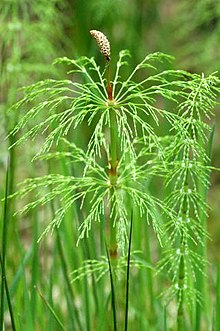Forest horsetail
| Forest horsetail | ||||||||||||
|---|---|---|---|---|---|---|---|---|---|---|---|---|

Forest horsetail ( Equisetum sylvaticum ) |
||||||||||||
| Systematics | ||||||||||||
|
||||||||||||
| Scientific name | ||||||||||||
| Equisetum sylvaticum | ||||||||||||
| L. |
The forest horsetail ( Equisetum sylvaticum ) is a species of horsetail ( Equisetum ). It is widespread in the northern hemisphere in warm temperate to cool Eurasia and North America .
Purpatsch is also used as a common name for the Pomerania region .
description
The forest horsetail is a perennial plant that reaches heights of 15 to 50 centimeters. It forms subterranean runners. There are multiple branched branches on the spikeless stems . They are very fine and thin, protruding horizontally, lying in one plane and overhanging slightly in a curve at the end, and overall result in a clearly storied structure. The internodes of the stem are 2.5 to 6.5 inches long and usually pretty much the same length. The 5 to 18 vaginal teeth are fused in groups of three to four, rarely up to six blunt lobes.
The spore ripening takes place from April to June. In the forest horsetail, the spore ear is initially pale and knotless sprouts. After the spores ripen, the spore ear usually falls off, the pale shoots turn green and branch out, as do the sterile shoots.
The number of chromosomes is 2n = 216.
Occurrence
The forest horsetail is widespread in the northern hemisphere in warm-temperate to cool Eurasia and North America . The distribution area extends north in the Arctic to Iceland , Novaya Zemlya and Greenland , in Europe south to northern Spain and northern Greece .
The forest horsetail thrives in damp forests, on mountain meadows and on mountain fields. It rises in the Alps to altitudes of 1850 meters. In the Allgäu Alps, it rises in the Tyrolean part between Hahnenkamm and Schneidspitze near Reutte up to 1700 m above sea level.
The forest horsetail indicates acidification and waterlogging. It avoids lime and is a shade to partial shade plant. The forest horsetail is a characteristic of the Alno-Ulmion-Verband, also occurs in damp Vaccinio-Piceion societies and in Galio-Abietenion stocks.
use
The forest horsetail is rarely used as an ornamental plant in humid groups of trees.
Web links
- Forest horsetail. In: FloraWeb.de.
- Forest horsetail . In: BiolFlor, the database of biological-ecological characteristics of the flora of Germany.
- Profile and distribution map for Bavaria . In: Botanical Information Hub of Bavaria .
- Equisetum sylvaticum L., map for distribution in Switzerland In: Info Flora , the national data and information center for Swiss flora .
- Distribution in the northern hemisphere according to Eric Hultén
- Thomas Meyer: Horsetail data sheet with identification key and photos at Flora-de: Flora von Deutschland (old name of the website: Flowers in Swabia )
- photos
supporting documents
- Eckehart J. Jäger, Friedrich Ebel, Peter Hanelt, Gerd K. Müller (eds.): Rothmaler excursion flora from Germany. Volume 5: Herbaceous ornamental and useful plants. Spectrum Academic Publishing House, Berlin Heidelberg 2008, ISBN 978-3-8274-0918-8 .
- Josef Dostál: Equisetaceae. In: Gustav Hegi : Illustrated flora of Central Europe . Volume 1, part I. 3rd edition, Paul Parey publishing house. Berlin, Hamburg 1984. ISBN 3-489-50020-2 .
- Jaakko Jalas, Juha Suominen: Atlas Florae Europaeae. Volume 1, Pteridophyta. Helsinki 1972.
Individual evidence
- ^ Georg August Pritzel , Carl Jessen : The German folk names of plants. New contribution to the German linguistic treasure. Philipp Cohen, Hannover 1882, page 142. ( online ).
- ↑ a b Dietmar Aichele, Heinz-Werner Schwegler: Our moss and fern plants. 10th edition, Franckh-Kosmos-Verlags-GmbH, Stuttgart 1993, ISBN 3-440-06700-9 .
- ↑ Erhard Dörr, Wolfgang Lippert : Flora of the Allgäu and its surroundings. Volume 1, IHW, Eching 2001, ISBN 3-930167-50-6 .




